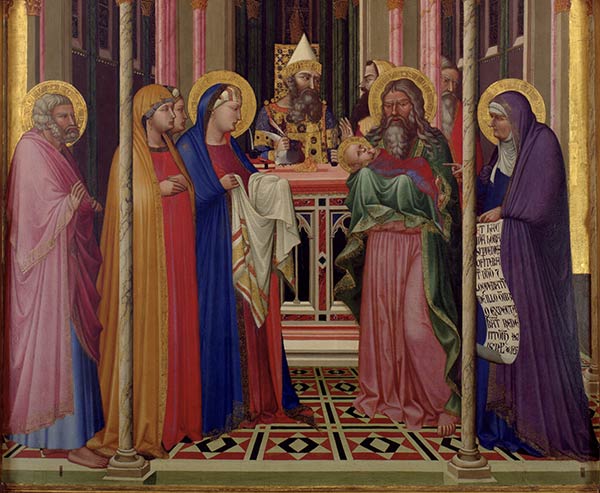While we insist that the apocrypha is not Scripture, that does not mean it has not influenced us greatly. Take for example the scene at the Nativity of our Lord. The Infancy Gospel of St. James, never anyone's part of the canon
of Scripture, has had great influence upon how we see some things. For example, one of the most enduring images of Christmas involves a detail omitted in Scripture but reported by the Infancy Gospel of St. James -- the ox and the ass at the manger.
The Presentation of Mary at the Temple, not the one known as Candlemas, is one of those details. In that story, the child Mary is presented by her parents (another detail is that here her
father was named a Levitical priest). It was, as it were, the return of the lost Ark to the Temple. Israel suffered no devastation greater than the capture
and loss of the Ark of the Covenant to their enemies. In one, by the Philistines, the consequences were like a Steven Spielburg movie script. Plagues began to afflict the Philistines until they begged Israel to come and get the Ark. Its return was heralded by a great celebration in Israel. When it arrived in Jerusalem, King
David took to naked dancing in the streets! You may remember the story. What a wonderful event it was when the Ark came home.
Later the Ark was lost again. This time the Babylonians sacked Jerusalem, destroyed the Temple, and took off with the Ark. That is about the last we heard of it. You may have heard the story that some Ethiopians claim to have it in the village of Aksum. The story is plausible but without any proof that it is indeed there, it is still but a guess. It was not this Ark, however, that returned to the Temple but Mary, blessed virgin, whose womb would bear the presence of God with His people and whose Son would redeem God's people from all their sins, once for all.
While I am not at all suggesting that the Infancy Gospel of St. James be given credibility here, the Presentation of our Lord and the Purification of the Blessed Virgin are, in a great sense, the return of the Ark to the Temple. In it as an infant Jesus is laying claim to His Father's house and Mary's role in this is attested by none other than the prophet Simeon.
The Virgin is the true Ark of God -- not of precious metal but of flesh that bears God's presence to us and opens the Holy of Holies. In the accounts of the dedication of the original Tabernacle of Moses and the First Temple of Solomon, the glory of God takes prominent place. When the
Second Temple was dedicated there was instead a dire warning connected to the prophecy of 1 Sam. 4:21, when the
daughter-in-law of the priest, Eli, died giving birth to a son. With her last breath, she named him “Ichabod” (“the glory has departed”).
According to the apocryphal account, when the child Mary enters the Temple in which the glory of God has
departed, she restores that glory -- though without notice or fanfare. The Infancy Gospel of James describes
her being taken into the Holy of Holies by Zachariah, her kinsman, whom we know only too well as the father of St. John the Forerunner.
The glory had departed until Jesus restored it, even at the cost of His own blood. The role of the Blessed Virgin in all of this remains prominent. What more can we say than Simeon said, longing for the consolation of Israel and the restoration of its glory, Now I can depart in peace for my eyes have seen thy glory. . .

3 comments:
Thank you, Father Peters. I preached on this day, the first time in 30 years I have had this fall on a Sunday and I was aware of it. It was very well received by the congregation who invited me. It was a blessing. I wish I would have had your insight about the Ark being restored to the Temple in Mary! Well done!
Yeah, but then again the Infancy Gospel of James almost takes on a gnostic or at least describes a not fully human birth of our savior. Describing the birth in terms that Christ just appeared rather than that he was birthed into the world. This is a problem if you believe that Christ was made to be like us in every respect. Other problematic apocryphal accounts such as the Ascension of Isaiah served to introduce threads into popular Christian piety that would lead to doctrines such as the bodily assumption of Mary and others that have been declared as de fide dogmas which must be accepted upon the threat of anathema from the Church. We should tread very carefully when expanding on doctrines the apostles did not hand down. The down the road consequences can be severe when we don't.
Mary riding a donkey comes from the Gospel of James - The Ox and Ass imagery though is picked up from Isaiah 1:3, “The ox knoweth his owner, and the ass his master's crib: but Israel doth not know, my people doth not consider.”
Post a Comment